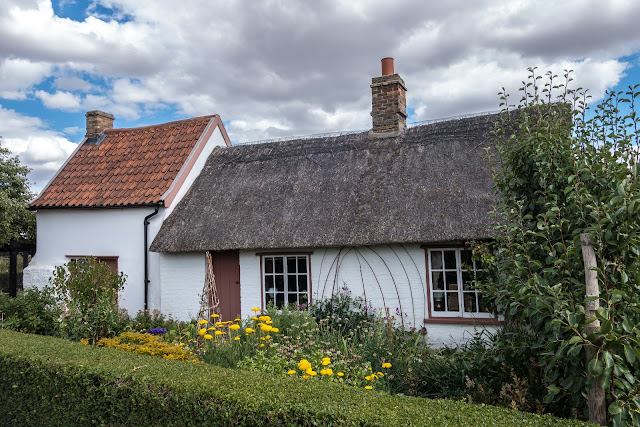The National Trust's oldest nature reserve, and England's most famous fen - Wicken Fen, one of Europe's most important wetlands, supports an abundance of wildlife. There are more than 9000 species, (I didn`t count them) including a spectacular array of plants, birds and dragonflies.
The raised boardwalk and lush grass droves allow easy access to a lost landscape of flowering meadows, sedge and reed beds, where you can encounter rarities such as hen harriers, water voles and bitterns. They have grazing herds of Highland cattle and Konik ponies which are helping to create a diverse range of new habitats. This site is always a delight to visit, and one of our favourites.
Fen Cottage. The cottage is one of the last surviving buildings of a once thriving hamlet whose residents lived and worked on the fen.
Built in various stages from the late 18th - early 20th Century, it was constructed from local materials including peat, wood, sedge, reed and clay, much of which would have been harvested or gathered from the Fen. Originally it was two separate cottages which were knocked into one in 1925.
Records dating back to 1841 show that the thatched cottage was home to Charles and Jane Butcher, with four generations of the family eventually living in the cottage. The last residents were Alice and her disabled son Reggie Butcher, who lived in the cottage until 1972, when Alice died, aged 93.
The National Trust acquired the cottage in 1974. Restoration began 1988, using local materials and techniques that would have been used in its original construction.
Red-eyed Damselfly
Tarnished Plant Bug
The Fen has been long associated with natural history. Charles Darwin collected beetles on the site in the 1820s. Many eminent Victorian naturalists collected beetles, moths and butterflies at Wicken Fen; some of their collections can still be found in museums. From the 1920s onwards the fathers of modern ecology and conservation, the Cambridge botanists Sir Arthur Tansley and Sir Harry Godwin carried out their pioneering work on the reserve. One of the world's longest running science experiments, the Godwin Plots, continues at the Fen to this day. The Fen’s long association with science, especially nearby Cambridge University, continues to the present day with scientists actively involved in the management of the reserve, and many hundreds of research papers published about the fen over more than a century
Tower Hide. This hide was built in the 1950's and it overlooks the Mere and Adventurers Fen. I believe there was work pending on this hide when we visited.
This little fellow was in danger of being stepped upon - Toad in the grass
Although Wicken Fen is often described as if it were a natural wilderness, it is neither natural nor wild; humans have been closely involved in the fen for centuries, and the reserve is still managed intensively to protect and maintain the delicate balance of species which has built up over the years.
Much of the management tries to recreate the old systems of fen working which persisted for hundreds of years, allowing species to become dependent on the practices. For example, the sedge plant, Cladium mariscus, is harvested every year and sold for thatching roofs. The earliest recorded sedge harvest at Wicken was in 1414, and ever since then, sedge has been regularly cut. The sedge-cutting has allowed an array of plants and animals to colonize the area that depend on regular clearance of the sedge in order to survive. (Many plants and animals are dependent upon regular management of vegetation in this way to keep their habitats intact.) As part of the management plan for Wicken Fen, Konik ponies and Highland cattle have been introduced to some areas in order to prevent scrub from regrowing.
The present appearance of Wicken Fen is the result of centuries of management by human beings. Many of the practices now undertaken have changed little since medieval times. In surrounding areas, the landscape has changed so completely that it is almost impossible to imagine how it must once have all looked. Only a very few places survive where it is possible to experience this primitive landscape first hand; Wicken Fen is one of these.

Windpump. Wicken Fen features the last surviving wooden windpump in the Fens. It is a small smock wind pump, which was probably built about 1912 at Adventurers' Fen for land drainage. The pump was moved to its present site and restored in 1956 by the National Trust. The Windpump now pumps water from the drainage channel up into the Fen to maintain a high water table. The nearby museums, Stretham Old Engine and Prickwillow Museum tell the story of how wind-pumps were succeeded by steam engines in the nineteenth century and diesel engines in the twentieth century.
The village church which we did not go into, perhaps another day? A small, simple but beautiful church dating from the thirteenth century so I am led to believe!

















































